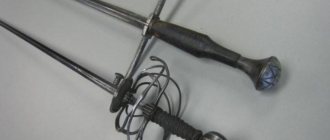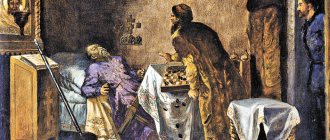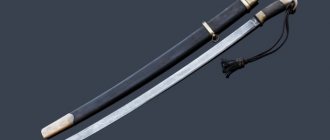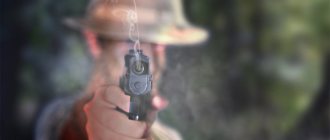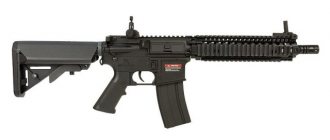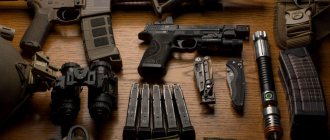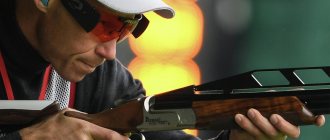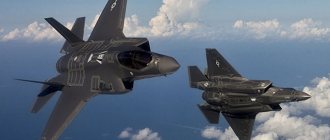Checker and saber, what is their difference
It is unknown exactly when the curved saber-type blade appeared. But the first such products first appeared on the territory of modern Iran and Turkey. Products appeared in Europe after the Crusades. In Rus', their appearance is associated with trade; blades were imported by merchants.
The history of the appearance of sabers and checkers
The first sabers can be called modified broadswords, which were created by Turkic gunsmiths around the 7th century AD. Edged weapons of that time showed certain advantages over swords. The blade was single-edged, curved, had impressive dimensions, but was at the same time quite light.
The weapon was popular with cavalry and was used against enemy foot forces. At the turn of the millennium, sabers became widespread in various regions. The warriors of Ancient Rus' were among the first to master the saber, and only then the weapon came to Eastern Europe and the Middle East.
The appearance of weapons changed significantly as they were used in various branches of the military. Optimization of saber characteristics for various tasks continued until the 19th century.
Experiments took place with the dimensions and weight of weapons, new versions of hilts and blade configurations were tried.
Saber.
The result was a great variety of sabers. Even the same subclasses are very different from each other. Almost every army had such weapons. It is simply useless to list countries; there are a great many of them. The saber has participated in many world conflicts.
European sabers of the New Age, with a blade length of 85-90 cm, had a bend of 40-50 mm. The navy used its own version - a boarding saber. It had a powerful hilt and a blade length of 50-60 cm. There are a very large number of varieties of sabers. This was certainly related to the method of use of the product.
Turkic blacksmiths again created a rather promising weapon - the saber. The first mentions date back to the 12th century. The appearance of the checker that we are accustomed to seeing was already established in modern times. In the distant past, some Caucasian peoples used it. It was only later that she came to the Terek and Kuban Cossacks.
Checker.
The saber entered service with some Russian structures in the 19th century. She even showed up in the army, seriously moving her saber. Surprisingly, the replacement of sabers with checkers occurred only in Russia. In other countries, sabers of existing designs were used, slightly modifying them.
Just like sabers, checkers managed to take part in many wars of the 19th century. The last military conflict for checkers was World War II. The development of edged weapons has reached its limit and made it almost the best and most convenient to use.
Examples of sabers and checkers.
The difference between a saber and a sword
Not all sabers are cutting-cutting; there are varieties that can also be used to thrust. The saber handle is designed for one hand only.
And the blade is on the convex side of the blade. Due to this shape, it does not just chop, but, as it were, cuts through the surfaces it meets.
As already stated, there are many types of sabers. They differ from each other:
- blade length;
- the shape of the blade bend;
- various forms of handles and hilts.
The most important difference between a saber and a sword is the location of the center of gravity. On a saber it is located at a considerable distance from the handle, in the area of the first or second third of the blade from the tip. Therefore, it turns out to be good at chopping with a cutting effect. The curved blade of the blade increases not only the force of the blow, but also the affected area. Main differences from the sword:
- curved blade, although there are sabers with a straight blade;
- the weight of a saber is significantly less than a sword;
- the saber handle is designed for one-handed holding;
- various fencing techniques;
- The saber blade is sharpened on one side, when swords are usually double-edged.
Saber and sword for clarity.
Description of the saber
The saber has a curved single-edged blade and, most often, an asymmetrical handle, in most cases at the end curved in the opposite direction from the blade. The guard of the saber, especially in the early periods of its existence, is a simple cross. Only from the end of the 15th century, the guard of the saber, like the guard of the sword, was enhanced with additional protective rings and shields.
The main parameters of a saber that influence its fighting qualities are:
- Blade length is the length of the axis drawn from the tip to the point where the blade (or heel) ends and the tang begins;
- The bend of the blade is the length of the perpendicular lowered from the highest point of the bend of the blade to this axis that determines the length. The cutting properties of the saber directly depended on the bend of the blade.
Saber structure
The general structure of a saber is practically no different from the structure of any other bladed weapon, but there are a number of details characteristic only of it.
1. Ephesus. 2. Blade. 3. Handle. 4. Pommel. 5. Cross. 6. Langet - serves to securely fix the saber in the sheath. 7. Butt - the back, unsharpened part of the blade (although sometimes there are sabers with double-sided sharpening). 8. Blade. 9. Elman - expansion in the lower third of the blade. As a rule, the yelman had a blade. Yelman is more typical for Turkish kilij and Polish sabers of the 16th - 17th centuries. 10. Point.
Due to its specific shape and structure, the saber has special properties that give it both advantages and disadvantages in battle, compared to a straight sword:
- A curved blade has a clearly greater cutting effect than a straight blade. This is due to the fact that the blade, with the same blade length, becomes longer due to its curvature. Due to the curvature, a blow applied directly acquires a pulling and at the same time a cutting effect. When struck, a curved blade has a more damaging effect than a straight blade.
- A curved blade makes it very difficult to thrust or (depending on the curvature) almost impossible. In this regard, the saber can be defined mainly as a chopping weapon and, to a lesser extent, as a piercing weapon.
Differences between a checker and a saber
It is pointless to compare individual examples of sabers and checkers, since there was a great variety of both. But in general, certain differences can be identified. During the period of the appearance of checkers, European-type sabers were in service in Russia. The blade had a clearly visible bend. The total length was 1 m, and the bend was 5 cm.
For good cutting blows, the blade was balanced in the middle part. The bend, one might say, is the most striking difference from other types of weapons. Thanks to it, you can make cutting and chopping movements. By increasing the curvature of the blade, the cutting ability increases; if you decrease it, the chopping effect will increase.
In the 19th century, checkers had much in common with sabers. The dimensions were almost the same and there was a slight curvature of the blade.
But the lack of a cross on the checker was immediately noticeable. There was also a weakly defined edge, and the center of gravity was not located in the middle of the blade, but closer to its end.
The use of the products also differed. You can attack and defend with a saber, while you can only attack with a saber. But learning to wield a saber was much easier. This is one of the reasons why it replaced the saber. The average size of a saber was 110 cm, and that of a checker was 88 cm, which played a certain role in the replacement of sabers with checkers.
Saber and checker, pay attention to the difference between the blade and the hilt.
Eastern sabers
The Shamshir, which appeared in Iran, was distinguished by a slightly curved blade with a one-sided sharpening, the hilt of this weapon resembled the crossguard of a sword, a simple straight handle, sometimes 5-6 degrees deflected down from the axis of the blade, with a straight crosspiece and a back rest.
The blade was equally wide along the entire length of the blade; the elman, actually the upper third of the blade from the tip, was underdeveloped. Shamshir was good at cutting through chain mail armor, but plate armor, the newest at the time of its appearance, was difficult for them to penetrate.
The Afghan saber is not very different from the shamshir, the only difference is in the stronger bend of the blade, and in the completely metal handle that is integral with the blade. The kilych worked well with armor plates. The blade of this saber, called klych in Rus', had a developed, weighted elman.
The kilych itself had a shorter and wider blade; if the width of the shamshir was on average 3-4 cm, then the width of the kilych could be up to 4-5 cm.
A heavier yelman improved the balance of the blade and made it possible to deliver heavier cutting blows. Tatar sabers also came from kilych and shamshir. The Cossacks of the Zaporozhye army were armed with the same weapons, who obtained weapons for themselves during their campaigns for zipuns. Later, these weapons came to the Don.
In Europe, kilych appears in service with the Hungarians and Russians, and it comes to them from the Ottomans. It was the fang, and not the shamshir, that was taken as a model for the Hungarian saber. It is worth considering that constant wars are raging in Europe at this time, and such weapons come in handy.
Sailors also appreciated the usefulness of a shorter blade. The development of artillery pieces at that time led to the fact that the main method of combat at sea was boarding; cannon fire was carried out for the sake of a psychological effect. On a swinging deck, in low-ceilinged cabins and in narrow corridors, such a cleaver was much more effective than a sword.
Types of sabers
Back in the days of ancient Egypt, there were special types of weapons that resembled a saber. Even remembering the ancient spatu blade, which was gradually improved, and gradually came to the saber. But several centuries passed before the saber we are used to seeing was produced. Let's look at saber models from ancient times to the present day:
- One of the first blades that vaguely resembled a saber was the Egyptian kopesh. Most historians classify these ancient blades as scimitars, but combat kopesh can also be classified as combat sickles. Only the elite warriors of the Egyptian army had such weapons. This is explained by the high cost and complexity of making kopesh. It was made of copper or bronze, so specimens have reached us in good condition.
- An improved model of the falcata sword, this is a scimitar. They gained popularity in the 16th century. The Turkish scimitar can easily be called the first prototype of a saber. The handle was made from animal bone. There were no guards at all. The concave blade was sharpened from the inside, which made it possible to easily cut off the heads or limbs of the enemy.
- A peculiar hybrid of a saber and a sword is a broadsword. It was used by heavy cavalry in the 18th century. The blade could be used to deliver piercing and slashing blows. But the broadsword already had a massive hilt that well covered the warrior’s fingers and hand.
- Naval troops used cutlass, they became very popular in the 16th-18th centuries. It was a simplified European military saber. The naval version of the saber had a well-developed guard.
- We must not forget about the follower of the saber - the saber. They are among the last melee weapons used on the battlefield until the mid-20th century.
Sabers from different times.
Old Russian saber: a weapon with potential for modernization
Saber of the 10th century from the collection of the State Historical Museum. According to the customs of that time, the saber was bent and damaged before being buried. Photo: Wikimedia Commons
Russian warriors were armed with a variety of bladed weapons. Various types of sabers remained in service the longest. The first such examples in the Old Russian army date back to the 10th century, and the full use of the saber continued almost until the beginning of the 20th century. Thus, sabers turned out to be the most durable type of bladed weapon in our army. The main features of sabers, laid down more than a thousand years ago, turned out to be useful later.
Weapons from the steppes
It is known that the first versions of the saber appeared in the 7th-8th centuries.
and quickly spread across a large part of Eurasia. Due to a number of characteristic features, the saber was a convenient weapon for a mounted warrior, which contributed to its rapid spread in different regions. Later, similar weapons appeared among the Eastern Slavs. Ancient Rus' became acquainted with the saber in the 9th-10th centuries. in connection with the raids of nomads. The principalities in the South and Southeast, which bore the brunt of the attack, were the first to recognize such weapons. The Old Russian army followed foreign innovations and tried to adopt the best ideas and developments. The same thing happened with the saber, but it was not immediately possible to reveal its potential.
Typology of saber hilt elements according to “Ancient Russian weapons” by A.N. Kirpichnikova
At the turn of two millennia, two new weapons appeared in the Russian army - a sword and a saber. The sword quickly took a dominant position and became the main bladed weapon. Over the next few centuries, the saber was inferior to it in distribution and mainly remained a specialized weapon.
It is curious that in the first period the saber was not only a warrior’s weapon, but also a status item. Several interesting finds date back to this period. In a number of burials, sabers with skillful decoration were discovered, showing the status and position of the owner in society.
In the XI-XII centuries. There is an increase in the number of sabers, and at the same time an increase in their share in the army. New technologies were mastered, which made it possible to increase output. At the same time, there is a proliferation of sabers. If previously they were used only in the southern principalities, then from the 11th century. reach Minsk and Novgorod.
Design Features
The sabers of Ancient Rus' were almost no different in design from similar weapons in other countries. The development of the design was carried out in approximately the same way as abroad. Over time, the shape and size of the blade changed, and at the same time the hilt was improved.
Sword and sabers of different types. Illustration from the book by A.V. Viskovatov “Historical description of clothing and weapons of Russian troops”
The earliest ancient Russian sabers had a single-edged blade about 1 m long, about 3-4 cm wide, with a slight bend. By the 12th century. the blade became 10-15 cm longer and slightly wider. The bending also increased and the mass increased. Thus, later sabers differed from their predecessors in greater force of the chopping blow, as well as higher cutting performance. Subsequently, these trends continued, which in the future led to the appearance of even more curved sabers.
Early Old Russian sabers, mostly richly decorated, were distinguished by the relative complexity of production. During forging, iron and steel plates were welded, and the finished blade was decorated with copper or gold wire. Later, as the saber spread, simpler technologies were used. Iron sabers with a welded steel blade or cemented solid iron samples were discovered. Naturally, such sabers were not decorated in any way.
The hilt changed quite actively. There are several main types of guards and pommels, characteristic of different periods and regions. Initially, straight guards with balls at the ends were present in Rus', also found in other countries. Subsequently, the shape of these products changed. The thickenings disappeared, the ends were lengthened and bent for greater ease of cutting and additional protection for the hand.
Other sabers from different eras. Illustration from the book by A.V. Viskovatov “Historical description of clothing and weapons of Russian troops”
Foot and horseback
Due to the correct ratio of length, width and bend, the saber has a combined chopping-cutting effect.
The double-edged end also allows for injections. Thanks to these qualities, the saber can be used by an infantryman or horseman. In a number of situations it has advantages over a sword with a straight double-edged blade. According to known data, the massive spread of the saber in Rus' was associated with the development of cavalry. It was the horsemen who were the main users of sabers, which is confirmed by archaeological finds. Sabers were also used in infantry, but in smaller quantities and only in certain regions.
The Old Russian saber developed and was used together with the sword, and these two weapons could compete with each other. However, this problem was solved in the most successful way. In the infantry of most principalities, the sword remained the main bladed weapon, and the saber could not significantly displace it. In the cavalry, reverse processes were observed: first in the southern regions, and then further, the saber began to displace the sword.
Saber attributed to Vladimir Monomakh. In fact, it is a product of the 17th century. Illustration from the collection “Antiquities of the Russian State”
Despite such processes, for several centuries the sword and saber remained equal weapons of warriors. There were no reasons for the disappearance of one sample and the greater spread of another. First of all, this was due to the specifics of the military-political situation. The opponents of Ancient Rus' were simultaneously heavily armed European warriors and highly mobile nomadic cavalry. To effectively combat them, different means were required, which affected the armaments of the Russian army in different regions.
Great future
Similar approaches to arming warriors persisted over the next few centuries.
However, in the XIV century. new processes began, the result of which was a change in the army’s weapons complex. The development of armies and tactics led to a gradual reduction in the role of swords and an increase in the share of sabers. In addition, the new sabers were somewhat similar to swords and could show similar characteristics. As a result, by the XV-XVI centuries. in the Russian army, the saber almost completely replaced the sword. In addition, new models of bladed weapons with certain features have appeared. New types of sabers, adapted to solve different problems, were created independently or borrowed from foreigners. In later periods, the saber remained one of the main weapons of the archers, local cavalry, Cossacks, foreign regiments, etc.
Sabers of Minin and Pozharsky, XVI-XVII centuries. Illustration from the collection “Antiquities of the Russian State”
The development of sabers proceeded by changing the shape and size of the blade, as well as by refining the hilt. Technologies for smelting metal and forging finished products were of decisive importance. The formation of a fencing school made it possible to more fully reveal the potential of weapons.
The great importance of the saber remained in modern times. New types of such weapons were developed and introduced, incl. intended for specific branches of the military. The saber retained its status as the main melee weapon of the Russian army until the end of the 19th century, when the mass introduction of checkers began. However, this did not lead to her rapid disappearance.
Ten centuries of development
The first discovered sabers of Ancient Rus' date back to the 10th century, but in fact such weapons could have appeared a little earlier. Later sabers remained in service until the 20th century. Thus, edged weapons with a curved blade and one-sided sharpening were relevant for a thousand years, which can be considered a real record.
Naval officer's sabers of the 19th century. Left - arr. 1855, on the right - arr. 1811 Photo by Wikimedia Commons
The reasons for such results should be sought in the successful concept and design of the blade. The saber is capable of piercing and chopping (with a cutting effect) blows, and is also relatively simple to manufacture and use. By making certain changes to the blade and hilt, the saber can be modified to meet specific requirements, which has happened many times in the past.
Over several centuries, master gunsmiths have used the full potential of the saber, which has led to well-known results. At first, this weapon was able to gain a foothold in the ancient Russian army and in some areas supplant the sword, and then completely replace it. After this, the saber remained one of the main weapons for several centuries. Not all types of melee weapons can boast such durability.
Russian saber
In Rus', this type of weapon appeared at the end of the 9th century. But the saber did not occupy a leading position then. But already from the 15th-16th centuries, edged weapons were put into service with the Russian cavalry. They also armed riflemen and Cossacks.
And since the 18th century, the saber was adopted by light cavalry personnel and officers of other troops.
The saber was replaced by the saber towards the end of the 19th century. And the main purpose of the saber was ceremonial wearing. The Russian fleet used a naval half-saber, with a blade length of 60 cm. Then it was replaced with a full-fledged one, with a blade length of 82 cm. The saber was made from Damascus steel. The handle was made of valuable wood or bone.
Russian saber.
Design
The classic saber had a slightly curved blade up to 850-900 mm long, the bend could be up to 50-70 mm, sharpened on the convex side. The upper third of the blade, up to the tip, was called elman; some sabers on elman had additional sharpening.
Along the blade part of the weapon there were valleys, which are sometimes called blood flows, although in reality they played a completely utilitarian role as stiffening ribs. The back of the blade was called the butt.
The Polish saber was already different from the eastern ones in its bend.
Later changes affected the hilt. European weapons had a full-fledged guard with a bow or several bows. The handle itself is in the form of an oval or ellipsoid in cross-section on the same axis as the blade. The butt plate usually had a hole for a lanyard.
The following types of sabers were distinguished by type of activity:
- cavalry, with a long blade and an indistinct tip;
- infantry, shorter blade, simplified handle;
- sea or boarding, usually pronounced elman, strongly curved blade, developed tip, most often closed handle.
The general appearance of the blade depended greatly on the conditions of its use. In addition to the statutory samples, noble officers often bought themselves more expensive, and therefore durable, blades made of Damascus steel or damask steel.
Sabers of the Eastern countries
Asian culture is associated primarily with the Ottoman Empire. In Medieval times, they had serious armed conflicts with European states. Sabers arrived in Europe as war trophies. They were occasionally imported by traders during short truces.
The most common and famous sabers at that time were the kilij saber from Turkey and the Persian shamshir. They have a greater blade bend than the European versions and the shape of their hilt is typical of eastern sabers. The hilt guard did not have shields or bows, but was like a regular crosspiece, the handle was a regular pistol type.
Eastern saber.
What is the difference between a checker and a saber
Very similar to each other, but at the same time very different. The checker, like the scimitar, originated from the knife, which over time acquired its dimensions and tasks.
The saber evolved from the sword and had a more complex and lengthy evolutionary path.
There are quite a lot of differences between these types of bladed weapons. First of all, this is the way of wearing it. The saber is worn with the blade down, while the blade of the checker looks up. This makes it much easier to remove from its sheath. The open handle of the checker, without a hilt or crosspiece, has only a beak.
When removing it, it is enough to pull it and the checker itself falls into the palm, while the saber is taken out with the hand overlapping. The second difference is in balancing; the saber is not only intended for chopping, it was created as a combined weapon.
For this reason, the balance of the saber is shifted towards the hilt, even in weapons with a developed and heavy hilt.
The center of gravity of the checker is shifted to the tip, this is done so that when chopping, the force of the blow also contributes to the weight of the blade.
The third is a purely visual difference. The checker always has an open handle without a cross or guard. The checker blade is not intended for thrusting and for this reason often has a rounded or blunted tip.
Cossack sabers
Cossack culture is closely connected with edged weapons. In the 15th century there were the first mentions of Cossack troops. In the 16th century, the Cossacks used a “klych” type saber or a copy of the Kievan Rus saber. They captured them in military campaigns or bought them from the Turks and nomadic peoples.
The Persian saber shamshir, made of damask or Damascus steel, was considered the best.
Only rich Cossacks could afford such specimens. But often these sabers were taken in battle; they were captured. The Adamashka saber was considered even no less valuable.
But this word was used to describe all crooked eastern sabers that were made from Damascus steel. The main attribute of a free Cossack was considered to be a saber. It was carefully preserved and passed on by inheritance. The Cossacks honed their fighting techniques on nomadic peoples. The Cossacks decorated the handles of their sabers with images of animals and birds, which served as a talisman.
Cossack saber shamshir
The development of the saber and its decline
The Europeans improved the saber in their own way; instead of the simple crosspiece common among eastern peoples, the hilts of European sabers received bows, and a guard appeared on some sabers. The butt rest was replaced with the usual apple.
A lanyard, a fabric or leather loop was attached to the handle, into which the owner's hand was threaded.
The blade of European sabers, unlike the eastern ones, had a weaker bend.
The Russian saber bore all the features of the Eastern saber: a strong bend of the blade, a characteristic handle with a developed back stop, and sometimes a characteristic tilt of the handle down from the axis of the blade.
The materials for the manufacture of these weapons were damask steel and Damascus; they were used mainly by boyars and serving nobles.
Later, kilyches made of Swedish iron appeared in the arsenal of some rifle regiments. This weapon was used by light cavalry, infantry and artillery; it was not for nothing that Artillery General Napoleon preferred combat sabers, one of which is kept in Moscow.
Napoleon's saber is distinguished by the excellent workmanship of the metal of the blade and the richness of its decoration, but, nevertheless, it is precisely a military weapon.
These weapons gradually conquered all of Europe. It was adopted by light cavalry regiments and infantry.
Heavy cavalry and nobles still preferred straight blades of broadswords and swords. But fencing with them required long and focused training, while the saber could be used with a minimum of skills.
Sabers were in service with infantrymen and sailors, artillerymen and sappers. Half sabers with a shorter blade length and cutlasses appeared. During mass production, everything superfluous and unnecessary in battle was removed from weapons. Handles and blades were simplified as much as possible.
Instead of developed hand protection, handles with a crosshair and one bow appeared.
Lanyards and butt pads of handles began to be used to apply distinctive signs and awards to them. In light horse regiments, officers' and soldiers' sabers also differed significantly in quality.
But edged weapons gradually left the scene. In the Russian cavalry in 1881 it was replaced by the saber, which was more convenient for slashing combat. In the USA, despite the fact that curved blades were in service with cavalry divisions, few people had heard of their use.
Due to the fact that the main task of the American army was guerrilla warfare with the indigenous people, saber attacks were used quite rarely. Therefore, for the Americans even then the saber had more of a ceremonial and ceremonial character. Although it was precisely because of the presence of blades that American cavalry regiments received the nickname “long knives.”
In Europe, it remained in service with the cavalry until the Second World War, but after it it finally turned into a ceremonial and ceremonial weapon.
Polish sabers
Representatives of the Polish gentry and soldiers of the hussar regiments were the first to use sabers. They began to gain popularity in the 15th century. The hussar cavalry liked the Polish saber. Hungarian samples of sabers, in the hands of the gentry, turned into ambition. At the very beginning, blades were imported into the country from Hungary.
But then they began to be manufactured in the Polish state, thus glorifying the Polish weapons school. The hussar saber first appeared in the 16th century; it became more widespread in the 17th century. It was the heaviest Polish saber. For a professional warrior it was an indispensable attribute.
Polish hussar saber.
Origin of the saber
The origins of the saber in its modern sense are rather unclear; it could have come from such medieval swords as the falchion, or from the early scimitar (cimitar) used in the Middle East, Indian subcontinent and Central Asia by Turkish and Mongol cavalry. Sabers first appeared in Western Europe with the arrival of the Hungarians there in the 10th century. The original type of Polish saber was the karabela. This name comes from the Turkish word "kara" meaning darkness and "bela" meaning curse. Karabela was used by the Polish, Lithuanian and Ukrainian nobility (gentry). Initially, the saber was used as a cavalry weapon, but gradually it replaced various cutting swords with straight blades on the battlefields. Over time, sabers became insignia in many armies around the world, and the uniform that includes the saber is still used today in the armies of some countries.
Types of fastenings
There are several options for attaching the sheath. Some of them depend on the material, but more often it is a matter of taste and convenience. Let's look at the most popular ones.
On the thigh
For such fastening, the sheath is attached to the top and bottom of the leg either with a special belt or with a cord. This type of mount is most often found among military personnel, hunters, or experienced wilderness survivalists. Not the best way for those who rarely handle a knife, as there is a very high chance of hurting yourself.
Japanese sword in sheath.
On the belt
The most common option, especially if the knife handle is not made specifically for the user’s hand. Attaches to the belt on either side. The disadvantage is the inconvenience of getting a knife while sitting.
Sheath for belt.
Shoulder
The rarest way to wear it is attached with a wide cord behind the back. Wear only with the handle down, when used in combat conditions. Without perfected skills, it is not recommended to carry knives and other cutting objects, as there is a high risk of damage.
Shoulder scabbard.
To the fisherman's vest
Such vests often have a place for a knife. If there is no pocket or it does not suit you, then the sheath is easily attached to special loops.
In popular culture
Sabers are used in many games, for example, in the world of WOW there is a very light saber; in the browser game “War Banner” there is a type of saber called the karabela. The saber is mentioned in many literary works and films.
In epics, proverbs and sayings. There is still a proverb in Tula: “marry a blacksmith, you will walk around and wave a saber,” in fact, this meant a real situation when the wives of blacksmiths-gunsmiths went out into the street waving red-hot blade blanks, cooling and hardening them.
Cutlass is praised by Sabbatini and Stevenson. Many children still portray Captain Blood, holding a wooden saber in their hands. In addition, many remember the times of the Union and the legends about the red cavalry, although the saber still played the main role there.
Replicas of mild steel sabers are still sold today; many people decorate their homes with collections of edged weapons.
The presence of a saber and checker on the carpet in the living room greatly decorates the interior of the house. At the same time, blades made of Damascus and damask steel are also sold, or rather with a pattern imitating them.
Turkish saber.
0
There are several types of sabers known in Turkey. a) sabers with a heavy wide blade with a sharp curve. Its handle is massive, made of bone or horn, thickening towards the large, bent back head, and the crosspiece is long and straight. The scabbard is wooden, covered with leather in the middle part, with a large mouth, a frame with two rings, and a very long tip. To make it easier to remove the blade, the sheath has a special cutout at the mouth; b) a lightweight saber of the same type with an Iranian-style blade, but with a sharp bend; c) light officer's saber of the second half of the 19th century. with a small handle of the usual type and a small cross with the ends bent towards the blade.
What does a Circassian saber look like?
The Circassian saber has the following features:
- lack of decoration;
- blade length - 70-80 centimeters;
- thin single-edged blade;
- the butt near the tip is not sharpened;
- unobtrusive front hand rest;
- large head (truncated).
Such checkers were originally intended for chopping attacks. But after Russian soldiers began to use weapons, the blades began to be sharpened so that they could pierce the enemy.
The weight of such a product does not exceed 700 grams. But this feature is typical for those models that were manufactured in the North Caucasus. Modern versions often weigh up to three hundred grams. These products are not used in battles, but are used primarily for domestic purposes (in particular, for cutting grapevines).
Blades are made primarily of steel (damask steel is less commonly produced). The section is longitudinal with different combinations:
- one or two;
- 2-3 in the upper part;
- under the butt;
- a wide valley combined with a narrow one.
The number and location of the fullers determine the properties of the blade. Despite the variety of configurations, these parts end at a distance of ¼ from the tip. In this part the blade acquires a lens-shaped cross-section. This is where the center of the impact is located. That is, this is the place where the Adyghe cut down the enemy.
I found a saber. What to do? Legalization of found bladed weapons
I found a saber. What to do?
There is no official mechanism for legalizing the found bladed weapons, according to the Ministry of Internal Affairs.
But there is still a way out!
A certain searcher has found a rusty saber or some other antique blade and wants to keep the find for himself. How can he legitimize the weapons found? It took quite a long time to find an answer to this seemingly simple question.
As it turned out, the law stipulates the obligation to register bladed weapons, but the mechanism for legalizing rare blades, in fact, does not exist. And in this case, what can the owner of the notorious saber do? Hand it over to the police or be held liable under Article 222 of the Criminal Code of the Russian Federation (“Illegal possession of weapons”). Both options will probably not suit our search engine. We tried to find a way out of the situation that would suit both the collector and law enforcement agencies.
Donate cannot be left
As soon as the employees of the licensing department at the Main Internal Affairs Directorate for the Irkutsk Region heard our question about the saber, they immediately reminded us about the campaign for the voluntary surrender of weapons. The fact is that not a single article of the Federal Law “On Weapons” provides for the legalization of cold steel or any other weapon. Since the found saber, by default, does not have a registration number and documents confirming the legality of its acquisition, it is impossible to register it.
At the same time, the found saber is a treasure that must be handed over to the state,” recalls Gennady Lobanov, head of the department of licensing and permitting work and control over private detective and security activities at the Main Internal Affairs Directorate for the Irkutsk Region. True, the search engine will not even receive a reward for voluntarily surrendering the saber. There is no monetary compensation for edged weapons. After the treasure hunter hands over the saber to the police department, the rare weapon will be sent for historical and cultural examination, and if it is recognized as a worthy exhibit, it will be transferred to the museum. However, moral satisfaction from a completed duty is not exactly the feeling that a treasure hunter wants to experience as a reward for exhausting hours of searching.
In the event that you still want to keep the found checker or sell it, you can use the options suggested below. A public security police officer, on condition of anonymity, agreed to talk about possible options for the fate of the found saber.
“If you want to keep a saber at home, please,” says the operative, “but for safety reasons, do not sharpen the blade sharply.” This item should be stored in such a way as to prevent access to it by unauthorized persons and spontaneous use as much as possible; store the saber, even if not in a safe, but securely attached to the wall. When asked what to do if, by chance or not, an attentive policeman happens to be in the apartment and demands clarification about a rare item, our interlocutor advises insisting that a saber or other rare blade is not a bladed weapon, but a collectible item.
If you want to completely protect yourself from the claims of law enforcement officers, then get an official document for your saber. The fact that your checker is of cultural value, as well as the time of its production, cost and other attributes, can be determined by specialists from a center for the preservation of historical and cultural heritage or a museum. True, such a service is not cheap.
There is another, less expensive, but also more risky way - still take your relic to the department of internal affairs at your place of residence and write a free-form statement: they say, I want to get a conclusion that the saber that belongs to me is of historical or cultural value. First, the saber, as they say, will be pierced through the base, that is, they will check whether there are any bloody crimes behind it and whether it is stolen. If there is nothing criminal associated with the blade, it will be sent for examination to an expert forensic center, which will conduct a historical and cultural examination. Having received an official conclusion, the saber can be transported within the country by any means of transport, including by plane.
In general, the information that we were able to collect on this issue is very contradictory. For example, in the laboratory of ancient technologies of the Irkutsk Polytechnic University, we were told that if a saber is recognized as cultural value, its place is not on the wall of a treasure hunter’s apartment, but in a museum.
How to become a collector
However, there is another option - to take advantage of the right to collect weapons, prescribed in the law, which, however, also does not describe the method of legalizing antique blades. The current Federal Law “On Weapons” enshrines the right of a citizen to collect weapons on the territory of the Russian Federation, and provides for the availability of an appropriate license.
A collection is a weapon acquired by a citizen for the purpose of collecting and exceeding the quantity established by Article 13 of the Federal Law “On Weapons” (currently this is more than five units of any type of civilian weapon). However, we must remember that it is not necessary to obtain licenses to collect types and models of civilian weapons, the acquisition of which is permitted freely, without licenses. For collecting purposes, it is permitted to purchase: weapons that are not prohibited for circulation on the territory of the Russian Federation, firearms, bladed weapons and other weapons removed from service by state paramilitary organizations, cartridges for the weapons listed above.
In order to obtain a license to collect weapons, a citizen submits an application in the prescribed form to the internal affairs authorities at the place of residence, a document proving his identity and citizenship of the Russian Federation; two photo cards measuring 3x4 cm.
A citizen has the right to store a collection of weapons and ammunition at his place of residence in locked safes or metal cabinets, boxes made of high-strength materials or wooden boxes lined with iron. The current legislation also provides for the implementation of state control over the collection of weapons. This means that employees of internal affairs bodies, together with representatives of specially authorized bodies for the preservation of cultural property, taking into account compliance with the requirements for ensuring the confidentiality of information about weapons and their owners, must carry out inspections of citizens who have their own collections or collections of weapons at least once a year . This measure is aimed primarily at ensuring the safety of weapons collections, which may include items of cultural value.


